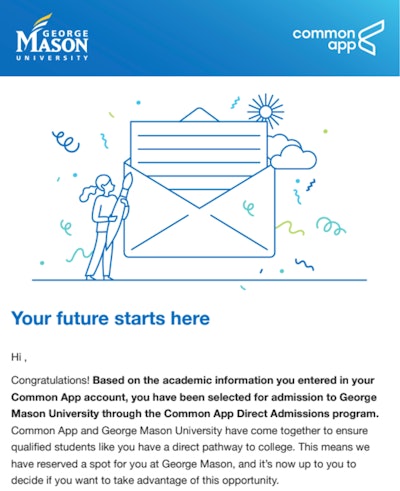For a prospective college student beleaguered by the complexities of the application process, direct admissions is like a dream come true. If their GPA or standardized test scores are high enough, colleges with direct admissions programs will send them acceptance letters without their even having to apply. All that’s required of them is to return a simplified form with no supplemental questions or essays. A fee waiver is included, to boot.
 Part of a direct admissions acceptance letter from the College App and George Mason University
Part of a direct admissions acceptance letter from the College App and George Mason University
The study, led by Dr. Taylor Odle, an assistant professor of educational policy studies at the University of Wisconsin-Madison, and Dr. Jennifer Delaney, an associate professor of higher education at the University of Illinois, Urbana-Champaign, was based on data from a direct admissions pilot program that has been run by the Common Application since 2021. Odle and Delaney studied the direct admissions process at six schools that are part of the pilot, some private, some public, some small, some large, and all ranging from moderately selective to open access. Two were Historically Black Colleges and Universities (HBCUs), and two were Hispanic Serving Institutions (HSIs). Data was obtained on the choices of almost 32,000 students.
As might be expected, receiving a near-automatic acceptance from a college made students likelier to follow up. The likelihood of a student “applying”—by sending back the simplified form—to a school that had directly accepted them doubled, to almost 4%. Getting a direct admissions letter also made students more likely to apply to any college at all, an increase of 12%.
Odle said that students tend to figure, “Once I’m in there, and I’ve already been admitted, why don’t I just go ahead and submit another application?”
Most underrepresented groups experienced bigger increases in the likelihood of application. Whereas white students who received a direct admissions offer were 2.4 percentage points more likely to apply to college anywhere, Black students were 3.7 points likelier. Non-first-generation students were 2.5 points likelier to apply, compared to 3.2 points for potential first-generation students.
 Dr. Taylor Odle, assistant professor of educational policy studies at the University of Wisconsin-Madison
Dr. Taylor Odle, assistant professor of educational policy studies at the University of Wisconsin-Madison
However, although direct admissions was successful in making students more likely to apply to college, it did not have the power to make them go. The researchers observed almost no change in the enrollment rates for students of any category. The reason comes down to money.
“[Direct admissions] doesn’t change the fact that they need to fill out the FAFSA. It doesn’t change the fact that they still actually have to pay for college,” said Odle. “It doesn’t really mean a lot if you’ve been directly admitted but you then can’t pay $10,000 a year to enroll.”
It’s a roadblock that Dr. Alan Byrd, dean of admissions at George Mason University, one of the schools in the Common App pilot, saw up close.
“When the Common App presented us with this opportunity, we jumped on it. Over 200 students accepted the offer. We had a lot of students who typically wouldn’t apply to Mason. We were excited,” he said in a press call about the research.
But then, things changed.
“We had quite a few students who deposited, who committed to us, but when they received their bills in July, they realized that Mason wasn’t affordable for them, even after taking out the max in student loans,” said Byrd. “It definitely made us realize that we need to make a significant investment in need-based aid.”
All in all, the researchers found that direct admissions was less impactful on application or enrollment than an offer of financial aid, conditioned on admission. Odle believes that the future of direct admissions may lie in bundling in monetary support.
“It’s not only, ‘Hey, you’ve been admitted,’ it’s ‘Hey, you’ve been admitted, and it’s been paid for,’” he said.
Although this might require some changes to schools’ complex financial aid machinery, Odle thinks that it’s possible.
“You can go to many institutions’ websites and they say, ‘If you have a 3.5 GPA and you got a 27 on your ACT, you’re eligible for a merit scholarship and that gets you $1,500,” he said. “Why do we have to wait for a student to fill out their form for you to tell them that?”
Those changes are likely years away, however. Until they happen, it would appear that direct admissions are a better technique for getting prospective students further down the pipeline than for getting them through the door.
“Direct admissions is an effective tool for connecting students with institutions,” said Odle. “But then it’s on the institution or the state to follow through with the other support services that are necessary to close the enrollment gap.”
Jon Edelman can be reached at [email protected]





















